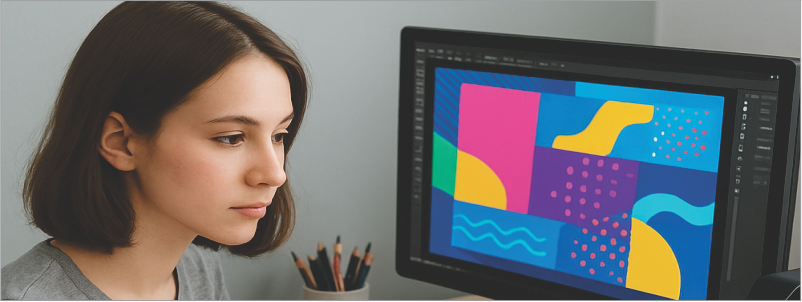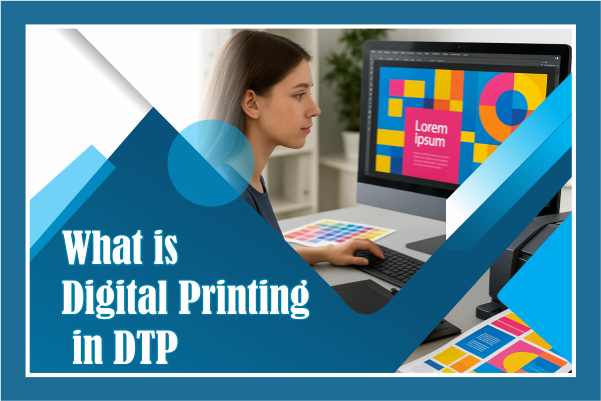In the fast-paced world of design and publishing, digital printing has revolutionized the way creative projects are executed. As part of the Desktop Publishing (DTP) process, digital printing plays a crucial role in transforming digital designs into physical prints. Whether it’s for marketing materials, business cards, or even photo books, digital printing has opened up new possibilities for designers, offering more flexibility, speed, and cost-effectiveness.
This blog post will explore the role of printing in DTP, its benefits, the different technologies used, and how it enhances the overall design process.
Understanding Digital Printing
Definition of Digital Printing
Printing refers to the process of printing digital images directly onto various media using a digital file (such as a PDF or JPEG) without the need for traditional printing plates. Unlike traditional methods, where each color is applied separately, digital printing involves printing the entire image in one go.
How Digital Printing Works
Printing works by sending a digital file to a printer, which uses either ink or toner to apply the image to paper or other substrates. The technology is faster and more efficient compared to traditional printing methods, as it eliminates the need for setup or plate creation.
Types of Printing Technologies
There are several types of digital printing technologies used in DTP:
Inkjet Printing:
This is one of the most common forms of digital printing. Inkjet printers use tiny droplets of ink that are sprayed onto the printing surface. They are capable of producing high-quality images and are widely used for both small and large print runs.
Laser Printing:
Laser printers use toner and a laser beam to produce images. Laser printing is fast and reliable, making it popular for high-volume printing tasks like business documents.
Dye-Sublimation Printing:
This printing method is often used for producing vibrant color prints, especially on fabric and plastics. Dye-sublimation is common for printing on materials like mugs, T-shirts, and photo prints.
Electrostatic Printing:
This involves the use of electrical charges to apply toner to a printing surface. It is used for high-speed printing and is highly efficient in large-format printing applications.
What is Desktop Publishing (DTP)?
Definition and Purpose of DTP
Desktop publishing (DTP) refers to the process of using computer software to create visual layouts for printed or digital materials. This includes everything from brochures and flyers to magazines and books. DTP allows designers to combine text, images, graphics, and other elements into professional layouts.
DTP offers the flexibility of digital design, which can be easily manipulated and edited before being sent to a printer for production. Without DTP, designing complex documents like catalogs or annual reports would be a much more labor-intensive and expensive process.
Key Components and Tools in DTP
Common tools used in DTP include design software such as Adobe InDesign, QuarkXPress, and Microsoft Publisher. These programs provide designers with the ability to create, modify, and organize content while ensuring that the layout is visually appealing and ready for printing.
The Role of Digital Printing in DTP
Integration of Printing in DTP Workflows
Digital printing has become an essential component of modern DTP workflows. The process begins with designing the layout on a computer using DTP software. Once the design is complete, the file is sent to a printer for production. Since digital printers are capable of producing high-quality prints directly from the digital file, there’s no need for intermediate processes like plate-making, which are common in traditional printing methods.
Benefits of Printing for DTP Projects
One of the key benefits of using Printing in DTP is the speed of production. Since digital files are directly printed without the need for setup, the turnaround time for a project can be much faster. Additionally, digital printing allows for shorter print runs, which is ideal for projects that require small quantities or personalized prints.
How Printing Enhances DTP Output
Digital printing can enhance the overall output of a DTP project by ensuring high-quality, vibrant prints. It also allows for color consistency, detailed images, and the ability to print on a variety of materials. These benefits contribute to better customer satisfaction and more polished final products.
Advantages of Printing in DTP
Cost Efficiency
Printing is cost-effective, particularly for small print runs or projects that require customization. Unlike traditional printing, there’s no need for expensive setup processes or large-scale manufacturing, which makes it a more affordable option for many design projects.
Faster Turnaround Times
Digital printing significantly reduces the production time for printed materials. Since there is no need to create plates or set up press equipment, printers can produce final prints in a fraction of the time it takes with traditional printing methods.
Customization and Flexibility
Digital printing offers the ability to personalize prints. From variable data printing to custom sizes and finishes, digital printing allows designers to create unique, tailored products that cater to individual needs and preferences.
High-Quality Output
One of the primary advantages of digital printing is the quality of the finished product. Digital printers can achieve sharp, vibrant, and accurate color reproduction, making it ideal for high-quality designs.

Common Digital Printing Technologies Used in DTP
Inkjet Printing
Inkjet printing is one of the most versatile types of digital printing. It uses liquid ink to create highly detailed and vibrant prints. Inkjet printers are often used in home and small business settings, as well as in commercial printing for things like posters and signage.
Laser Printing
Laser printers are commonly used for professional business printing. They offer fast printing speeds and produce crisp text and fine details. Laser printing is suitable for printing documents, marketing materials, and other professional content.
Dye-Sublimation Printing
This technology is particularly effective for printing onto fabrics and textiles. Dye-sublimation uses heat to transfer dye onto a material, resulting in vibrant and durable colors. It’s commonly used for creating custom apparel, banners, and promotional items.
Electrostatic Printing
Electrostatic printing is often used in larger industrial printing systems. It works by using static electricity to attract toner particles to the printing substrate. This process is particularly useful for high-speed, large-format printing applications.
Applications of Digital Printing in DTP
Brochures, Flyers, and Posters
Digital printing is widely used for creating promotional materials such as brochures, flyers, and posters. These items benefit from the high-quality, customizable nature of digital printing, enabling businesses to produce eye-catching designs in short runs.
Business Cards and Stationery
Business cards, letterheads, and envelopes can all be produced using digital printing. With digital technology, designers can offer personalized designs and quickly adjust details such as names, logos, and addresses.
Photo Books and Magazines
For photographers and graphic designers, digital printing is an ideal solution for producing photo books, magazines, and catalogs. The precision and color accuracy of digital printing ensure that images are reproduced faithfully.
Packaging and Labels
Digital printing is also widely used in the packaging and labeling industries. Companies can print product labels, packaging designs, and promotional materials quickly and affordably.
Challenges of Digital Printing in DTP
Print Quality Concerns
While digital printing generally offers high-quality prints, some concerns can arise, such as color consistency and print resolution. It’s important to calibrate printers and monitor the print quality to ensure the desired results.
Limited Paper Choices
Unlike traditional printing methods that offer a broad range of paper stocks, digital printing may be limited to specific paper types. This can restrict the options available for projects that require unique or specialty materials.
Color Management Issues
Color matching between digital files and prints can sometimes be challenging. To achieve the best color output, designers need to carefully calibrate their printers and work with color profiles to ensure accuracy.
Cost of Equipment and Maintenance
While digital printing is cost-effective for small runs, the initial cost of high-quality digital printers can be expensive. Additionally, ongoing maintenance and ink/toner replacement costs should be factored into any print project.
Future Trends in Digital Printing and DTP
Advancements in Printing Technologies
As digital printing technology evolves, we can expect to see even more advanced printing systems that offer higher resolution, faster speeds, and more versatile media options. Innovations such as 3D printing could also impact DTP, allowing for new creative possibilities.
Eco-Friendly Printing Solutions
With growing concerns about the environment, the future of digital printing will likely include more sustainable practices. This could include the use of eco-friendly inks, recyclable materials, and energy-efficient printing equipment.
Personalized and On-Demand Printing
The demand for personalized, on-demand printing will continue to rise. Digital printing offers businesses the ability to create customized products for consumers, whether it’s personalized photo gifts, unique marketing materials, or small-batch printing for niche markets.
Conclusion
Digital printing has become a cornerstone of modern Desktop Publishing (DTP), offering numerous benefits including cost efficiency, high-quality output, and faster turnaround times. The integration of digital printing in DTP workflows allows designers to bring their creations to life with unmatched precision and flexibility.
As printing technologies continue to evolve, digital printing will likely remain a key player in the world of design and publishing, making it easier than ever to produce customized, professional-grade printed materials on demand.

